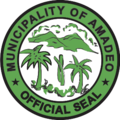This article needs additional citations for verification .(January 2016) |
Amadeo | |
|---|---|
| Municipality of Amadeo | |
Municipal Hall Saint Mary Magdalene Parish Church Amadeo Coffee Culture and Heritage Mural | |
| Nickname: Coffee Capital of the Philippines | |
| Motto: Tapat may Integridad at Kaagapay ng Lahat | |
 Map of Cavite with Amadeo highlighted | |
 Interactive map of Amadeo | |
Location within the Philippines | |
| Coordinates: 14°10′22″N120°55′40″E / 14.172803°N 120.927681°E | |
| Country | Philippines |
| Region | Calabarzon |
| Province | Cavite |
| District | 7th district |
| Founded | July 15, 1872 |
| Annexation to Silang | October 15, 1903 |
| Chartered | January 1915 |
| Founded by | Rafael Izquierdo y Gutiérrez |
| Named after | King Amadeo I of Spain |
| Barangays | 26 (see Barangays) |
| Government | |
| • Type | Sangguniang Bayan |
| • Mayor | Jose R. Domingo Jr. |
| • Vice Mayor | Joseph R. Legaspi |
| • Representative | Crispin Diego D. Remulla |
| • Municipal Council | Members |
| • Electorate | 28,753 voters (2025) |
| Area | |
• Total | 36.92 km2 (14.25 sq mi) |
| Elevation | 357 m (1,171 ft) |
| Highest elevation | 697 m (2,287 ft) |
| Lowest elevation | 95 m (312 ft) |
| Population (2024 census) [3] | |
• Total | 44,190 |
| • Density | 1,197/km2 (3,100/sq mi) |
| • Households | 10,317 |
| Economy | |
| • Income class | 4th municipal income class |
| • Poverty incidence | 9.57 |
| • Revenue | ₱ 203.6 million (2022) |
| • Assets | ₱ 295.3 million (2022) |
| • Expenditure | ₱ 177.3 million (2022) |
| • Liabilities | ₱ 74.29 million (2022) |
| Service provider | |
| • Electricity | Manila Electric Company (Meralco) |
| Time zone | UTC+8 (PST) |
| ZIP code | 4119 |
| PSGC | |
| IDD : area code | +63 (0)46 |
| Native languages | Tagalog |
| Website | www |
Amadeo, officially the Municipality of Amadeo (Tagalog : Bayan ng Amadeo), is a municipality in the province of Cavite, Philippines. According to the 2024 census, it has a population of 44,190 people. [5]







